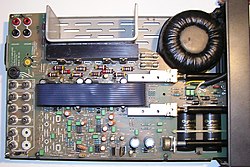This article needs additional citations for verification. (April 2019) |


An audio power amplifier (or power amp) amplifies low-power electronic audio signals, such as the signal from a radio receiver or an electric guitar pickup, to a level that is high enough for driving loudspeakers or headphones. Audio power amplifiers are found in all manner of sound systems including sound reinforcement, public address, home audio systems and musical instrument amplifiers like guitar amplifiers. It is the final electronic stage in a typical audio playback chain before the signal is sent to the loudspeakers.
The preceding stages in such a chain are low-power audio amplifiers which perform tasks like pre-amplification of the signal, equalization, mixing different input signals. The inputs can also be any number of audio sources like record players, CD players, digital audio players and cassette players. Most audio power amplifiers require these low-level inputs, which are line level.
While the input signal to an audio power amplifier, such as the signal from an electric guitar, may measure only a few hundred microwatts, its output may be a few watts for small consumer electronics devices, such as clock radios, tens or hundreds of watts for a home stereo system, several thousand watts for a nightclub's sound system or tens of thousands of watts for a large rock concert sound reinforcement system. While power amplifiers are available in standalone units, typically aimed at the hi-fi audiophile market (a niche market) of audio enthusiasts and sound reinforcement system professionals, many consumer electronics audio products such as an integrated amplifier, a receiver, clock radios, boomboxes and televisions have both a preamplifier and a power amplifier contained in a single chassis.
- ^ "1 – Integrated Amplifier (All Versions)". Archived from the original on 2011-04-24. Retrieved 2011-01-16. Cyrus Audio: Product Archive: Cyrus One